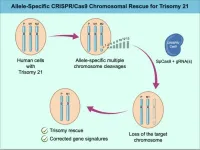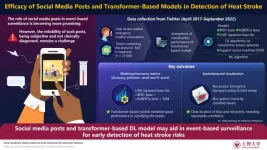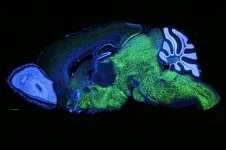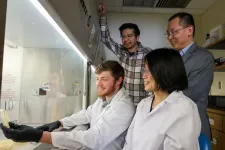(Press-News.org) Despite similar availability of diagnostic technologies to women of different racial and ethnic groups, significant disparities were seen in who actually received same-day diagnostic services and biopsies after abnormal mammogram findings, new research shows. Even when breast-care facilities had the necessary technology and capabilities, minority groups were less likely than white women to receive diagnostic imaging on the same day as an abnormal screening result. Black women in particular were less likely to receive same-day biopsies, compared with white women.
The findings of a retrospective study are to be published Feb. 18 in the journal Radiology. The lead author is Dr. Marissa Lawson, assistant professor of radiology at the University of Washington School of Medicine. Dr. Christoph Lee, UW professor of radiology, was senior author.
“We’re looking at how the diagnostic workup process might contribute to the population disparities we see with breast-cancer outcomes,” Lawson said. “It was surprising to find similar availability (of technologies) across racial and ethnic groups. But we still saw big differences in who was getting those same-day services.”
The retrospective study spanned nearly 11 years, from January 2010 to December 2020. The data represented more than 1.1 million female patients ages 40-89 and more than 3.5 million screening mammograms. The patients were seen in six U.S. states at 136 screening facilities that, as members of the Breast Cancer Surveillance Consortium, make data available for study.
The screening results were from individuals who self-identified as Asian (10%), Black (13%), Hispanic/Latinx (6.5%), white (68%) and “All others” (2%).
With the multilevel analysis, the researchers hoped to shed light on how factors such as race and ethnicity, household income and neighborhood educational attainment affected access to, and use of, breast-cancer diagnostics.
In the study, they first identified which consortium facilities offered onsite access to both standard-care and advanced diagnostics and biopsy. They then measured patients’ access to these capabilities, discerned which screening mammograms yielded an abnormal result, and evaluated those patients’ receipt of diagnostic imaging and biopsy on the same day and within 90 days at facilities that had the technology and capability onsite.
The researchers adjusted for several potentially influential factors such as patient breast density, biopsy history, personal and family history of breast cancer.
Asian, Black and Hispanic/Latinx patients received fewer same-day diagnostic services after undergoing a screening mammography with abnormal results at facilities offering any diagnostic or biopsy services. Patients who lived in the lowest-income neighborhoods were 58% less likely to have same-day diagnostic evaluations than those living in the highest-income neighborhoods.
Notably, Lawson said, rural-resident patients were more likely to receive same-day diagnostic services than were urban residents.
Black patients and those who lived in a relatively lower median income were less likely than white patients to receive same-day biopsy at a capable facility. However, Hispanic/Latinx patients were more likely than white patients to receive same-day biopsy.
“Getting a screening mammogram is an anxiety-inducing experience for a lot of people, and most patients I encounter want their results as soon as possible,” Lawson said.
“If you're able to do a diagnostic workup on the same day, instead of making them wait to schedule a follow-up visit — which might create a headache with work or transportation — that’s better for the patient. And if treatment is advised based on imaging and biopsy, we should do all we can to shorten the time between screening and treatment (for those diagnosed with breast cancer).”
The authors acknowledged several limitations, including a study population that might not be nationally representative of women’s education and rural residency. Variables that might affect patients’ ability to take advantage to clinic services, such as employment, insurance status, transportation barriers and childcare needs, were not included in the analyses. It also is unknown whether individual patients declined the opportunity for same-day services or were not offered such services.
The study received funding from the National Cancer Institute (R01 CA266377,
P01 CA154292)
###
END
Racial disparities seen in care after abnormal mammograms
Despite subpopulations’ similar onsite access to diagnostics and biopsy, the use of those capabilities varied, a study shows
2025-02-18
ELSE PRESS RELEASES FROM THIS DATE:
New research brings hope for improved outcomes and survival rates for patients facing a pancreatic cancer diagnosis
2025-02-18
New research brings hope for improved outcomes and survival rates for patients facing a pancreatic cancer diagnosis
The discovery of a 'biomarker panel' could have a profound impact on the ability to identify patients at risk of developing PC at an earlier stage
Pancreatic cancer (PC) is the worst prognosis cancer globally, with just 13% of patients who are diagnosed with PC surviving for 5 years or more after initial diagnosis. In Ireland, there are approximately 900 cases of PC per year, and 820 PC-related deaths. Early detection of PC is the primary concern of most PC research, as it has the potential to make a substantial difference to the treatment and survival of patients.
Survival ...
Using CRISPR to remove extra chromosomes in Down syndrome
2025-02-18
Gene editing techniques may eventually allow trisomy to be treated at the cellular level, according to an in vitro proof-of-concept study. Down syndrome is caused by the presence of a third copy of the 21st chromosome. The condition occurs in approximately 1 in 700 live births and is relatively easy to diagnose at early stages of development. However, there are no treatments. Ryotaro Hashizume and colleagues use the CRISPR-Cas9 gene editing system to cleave the third chromosome in previously generated trisomy 21 cell lines derived from both pluripotent cells and skin fibroblasts. The technique is able to identify which chromosome has been duplicated, ...
Social media posts and transformer-based models for early detection of heat stroke
2025-02-18
Heat stroke poses a significant health risk, especially during extreme temperature conditions. As global temperatures rise due to climate change, the frequency and severity of heatwaves have increased, putting vulnerable populations at greater risk. This shift underscores the need for effective, real-time methods for early detection and response to heat stroke risks, ensuring timely intervention and reduced impact of these rising threats. While previous studies have highlighted the potential of social media posts, such as tweets, to offer real-time insights into various events, its application in detecting heat stroke risks ...
Restoring grasslands led to fewer human-wildlife conflicts in Kenya, research finds
2025-02-18
ARLINGTON, Va. (Feb. 18 2025) – A new study led by Conservation International scientists and published today has found that grassland restoration can reduce human-wildlife conflict and social conflicts in communities facing resource scarcity.
Grasslands, vital ecosystems for livelihoods and biodiversity, are under increasing pressure from climate change and human activity. The Chyulu Hills region of Kenya exemplifies these challenges, as it is home to iconic wildlife such as African elephants and black rhinos, which share the land with pastoral Maasai communities. This coexistence often leads to competition over limited water, land and pasture, sparking ...
What makes us remember our dreams?
2025-02-18
Some people wake up vividly recalling their dreams from the night, and can tell precise stories experienced during the night, while others struggle to remember even a single detail. Why does this happen? A new study, conducted by researchers at the IMT School for Advanced Studies Lucca, and published on Communications Psychology explores the factors that influence so called "dream recall"— the ability to remember dreams upon awakening—and uncovers which individual traits and sleep patterns shape this phenomenon.
The reason why there is such a difference in recalling dreams remains a mystery. Some studies found that women, young persons, ...
New tool reveals disruption of immune cells in blood is linked to cancer outcomes
2025-02-18
The immune systems of cancer patients are highly disrupted, with those who have a higher number of immune cells in their blood having a better survival rate, finds a new study that uses a pioneering technique developed by researchers at UCL and the Francis Crick Institute.
The tool, described in Nature Genetics, is called Immune Lymphocyte Estimation from Nucleotide Sequencing (ImmuneLENS). It enables researchers to calculate the proportion of T cells and B cells (types of immune cell) from whole genome sequencing (WGS) data for the first time.
Whole genome sequencing (WGS) uses a blood sample to create a complete ...
Newfound circuit better explains how the brain recognizes what is familiar and important
2025-02-18
*** Embargoed for release until Tuesday, Feb. 18, 2025, at 5 a.m. EST ***
A newly identified part of a brain circuit mixes sensory information, memories, and emotions to tell whether things are familiar or new, and important or just “background noise.”
Led by researchers from NYU Langone Health, the work found that a circuit known to carry messages from a brain region that processes sensory information, the entorhinal cortex (EC), to the memory processing center in the hippocampus (HC) has a previously unrecognized pathway that carries messages directly back to the EC.
Publishing online Feb. 18 in Nature Neuroscience, the study results show that this direct feedback ...
A single protein may have helped shape the emergence of spoken language
2025-02-18
The origins of human language remain mysterious. Are we the only animals truly capable of complex speech? Are Homo sapiens the only hominids who could give detailed directions to a far-off freshwater source or describe the nuanced purples and reds of a dramatic sunset?
Close relatives of ours such as the Neanderthals likely had anatomical features in the throat and ears that could have enabled the speaking and hearing of spoken language, and they share with us a variant of a gene linked to the ability to speak. And yet it is only in modern humans that we find expanded brain regions that are critical for language production and comprehension.
Now researchers from The Rockefeller University ...
Scientists decode diet from stool DNA – no questions asked
2025-02-18
SEATTLE – Scientists have developed a breakthrough method to track diet using stool metagenomic data.
Developed by researchers at the Institute for Systems Biology (ISB), the new method, called MEDI (Metagenomic Estimation of Dietary Intake), detects food-derived DNA in stool samples to estimate dietary intake. MEDI leverages stool metagenomics, which refers to sequencing all the DNA present in fecal samples (including microbial, human, and food-derived DNA). This non-invasive, data-driven approach offers an objective alternative to traditional food diaries and questionnaires, ...
Biologists transform gut bacteria into tiny protein pharmacies
2025-02-18
Hundreds of different species of microbes live, laugh, and love in your gut. In the future, one of these might serve a new function: microscopic in-house pharmacist.
A new study published Feb. 18 in Nature Biotechnology shows how gut bacteria can be directed to produce and release proteins within the lower gastrointestinal tract — eliminating a major roadblock to delivering drugs to that part of the body.
Oral medication is the most common and practical means of drug administration, but the stomach doesn’t let much pass through unscathed. This is good when it comes to things like foodborne ...
LAST 30 PRESS RELEASES:
Scalable and healable gradient textiles for multi‑scenario radiative cooling via bicomponent blow spinning
Research shows informed traders never let a good climate crisis go to waste
Intelligent XGBoost framework enhances asphalt pavement skid resistance assessment
Dual-function biomaterials for postoperative osteosarcoma: Tumor suppression and bone regeneration
New framework reveals where transport emissions concentrate in Singapore
NTP-enhanced lattice oxygen activation in Ce-Co catalysts for low-temperature soot combustion
Synergistic interface engineering in Cu-Zn-Ce catalysts for efficient CO2 hydrogenation to methanol
COVID-19 leaves a lasting mark on the human brain
Scientists use ultrasound to soften and treat cancer tumors without damaging healthy tissue
Community swimming program for Black youth boosts skills, sense of belonging, study finds
Specific depressive symptoms in midlife linked to increased dementia risk
An ‘illuminating’ design sheds light on cholesterol
Who is more likely to get long COVID?
Study showcases resilience and rapid growth of “living rocks”
Naval Research Lab diver earns Office of Naval Research 2025 Sailor of the Year
New Mayo-led study establishes practical definition for rapidly progressive dementia
Fossil fuel industry’s “climate false solutions” reinforce its power and aggravate environmental injustice
Researchers reveal bias in a widely used measure of algorithm performance
Alcohol causes cancer. A study from IOCB Prague confirms damage to DNA and shows how cells defend against it
Hidden viruses in wastewater treatment may shape public health risks, study finds
Unlock the power of nature: how biomass can transform climate mitigation
Biochar reshapes hidden soil microbes that capture carbon dioxide in farmland
Reducing saturated fat intake shows mortality benefit, but only in high-risk individuals
Manta rays create mobile ecosystems, study finds
Study: Mixed results in using lipoic acid to treat progressive multiple sclerosis
Norbert Holtkamp appointed director of Fermi National Accelerator Laboratory
New agentic AI platform accelerates advanced optics design
Biologists discover neurons use physical signals — not electricity — to stabilize communication
Researchers discover that a hormone can access the brain by hitchhiking
University of Oklahoma researcher awarded funding to pursue AI-powered material design
[Press-News.org] Racial disparities seen in care after abnormal mammogramsDespite subpopulations’ similar onsite access to diagnostics and biopsy, the use of those capabilities varied, a study shows



